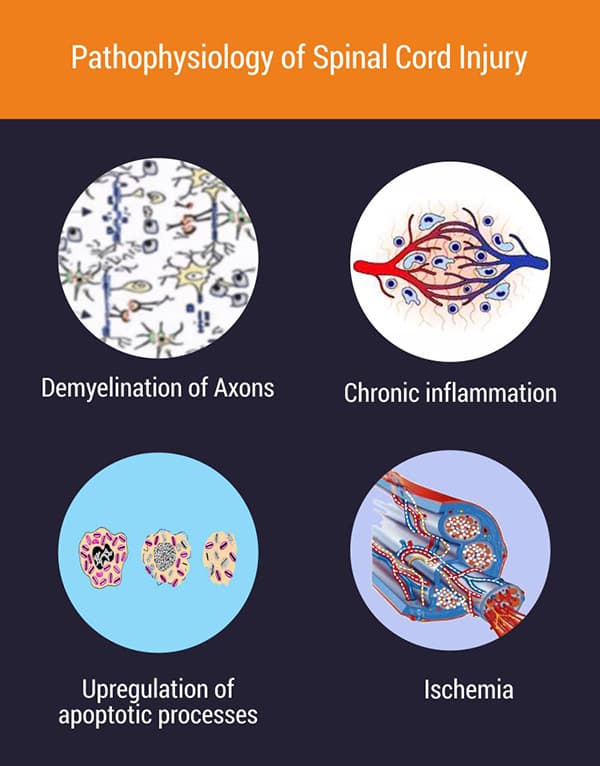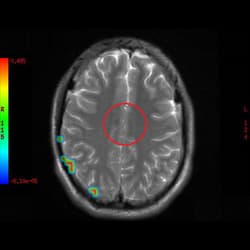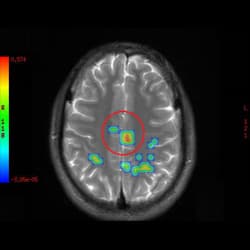A Spinal Cord Injury damages the nerve cells and causes an inflammation. The first response for a Spinal Cord Injury Treatment is always to stabilise the spine to prevent any further spinal cord damage. Intense rehabilitation, so as to prevent any permanent deformities in the limbs affected, as well as to stimulate a response from the affected parts is the second step of a spinal cord injury treatment.

Autologous Bone Marrow Mononuclear Cells Grafting Autologous Bone Marrow Mononuclear Cells Grafting for spinal cord injury has great potential. Extensive research has been conducted in animal models and humans in autologous bone marrow mononuclear cells grafting for spinal cord injury. It focuses on replacing the lost or damaged cells and promoting axonal growth and remyelination of axons for spinal cord treatment. The cells migrate to the site of injury and initiate a repair process. They release trophic factors to stop neuronal degeneration and stimulate angiogenesis. These factors also activate the dormant cells and recruit them to the injured site.
The advancement of Autologous Bone Marrow Mononuclear Cells Grafting for spinal cord injury in India, has been dramatically changing the perception that individuals who suffer spinal cord injuries are destined to a life of bedridden exile. At NeuroGen, in India, cell treatment for spinal cord injury has shown the following improvements:
Improved trunk control
Standing balance
Sitting balance
Spasticity
Sensation
Bladder movements
Improved postural hypotension
In acute thoracolumbar injury and paraplegia, 91%
In cervical injury and quadriplegia, 74%


Pre Autologous Bone Marrow Mononuclear Cells Grafting FMRI showing no activity in the frontal areas of the brain


Post Autologous Bone Marrow Mononuclear Cells Grafting FMRI showing new activity in the frontal areas of the brain suggesting a positive response to the treatment.
Regenerative Medicine for Spinal cord Injury in India, at NeuroGen involves a holistic & individualised approach. We have a dedicated Spinal Cord Injury Treatment Walking track for our patients. The rehabilitation provided is a revolutionary method of rehabilitation of spinal cord injury patients. This rehabilitation process is known as "Kunming locomotor training" carried out on a special walking track for patients with spinal cord injury and paraplegia. This program includes progressive training to improve weight bearing and walking without splints or any assistive devices. It is based on the rule of 6 which is "6 hours of walking per day for 6 days a week for 6 months" using Kunming walker. This often leads to patients with paraplegia walking independently without splints at the end of 6 months.
Paraplegia can be defined as losing control of movement and sensation from the waist down whereas the term Quadriplegia includes loss of function in the upper body, arms and hands.
By Complete spinal cord injury we mean injuries that have effectively no transmission of signals across a spinal cord lesion and no voluntary control of movement or perception of sensations below the lesion. Whereas by Incomplete’ injuries we mean, the undamaged pathways across the spinal cord lesion. The outcome can be extremely changeable depending on which parts of the spinal cord are damaged.
There is some possibility for some function to recuperate after a spinal cord injury. It is important that the main measures to reduce the injury should be taken immediately after any spinal cord injury. This helps in preventing secondary injuries and reduces the severity of the problem.
There are chances of spinal cord injuries getting healed after a period of time in some cases. But the same cannot be said about the central nervous system. The injury caused on the spinal cord and brain takes time to heal. An effort can be made to regenerate new cells by stopping the mechanisms that end neurons from growing.
A spinal cord injury will not decrease the mortality rate of a person. Some complications may occur if proper care is not taken in time for a spinal cord injury. There are problems that occur like chronic kidney failure, chest infections and deep vein thrombosis. If all the complications are treated in time, the minor issues can be thwarted.
We keep our treatment focus on surgery or fixing of the vertebra. Caretakers and patients need to be counseled about, what to expect after injury. They should understand that a spinal cord injury extends over a period of six months. At the initial stage, the hands and legs would be loose or flaccid. At a later stage, it becomes stiff and spastic. It should be followed up with physiotherapy or rehabilitation session. Remember to turn over the patient every two hours to prevent bedsores. The patients need to drink a lot of liquid in order to prevent urinary tract infection.
Sexual function of a patient gets generally affected with a spinal cord injury. It is possible to revitalize the patient, with the help of an andrologist. In our experience, we have observed that with the help of medicines the males with sexual dysfunction have been able to have intercourse.
The essential role of rehabilitation is to help patients with spinal cord injuries and help them become more independent with their daily activities. NeuroGen provides a tailor-made therapy protocol for every patient, with the intent of achieving this independence.
autologous bone marrow mononuclear cells grafting is possible for treating spinal cord injuries. Transplantation studies in animals have shown that a transplantation of bone marrow-derived cells or stem-cell-derived cells may add to spinal cord repair by: The interchangeability of the nerve cells that may have passed on owing to producing new cells that restructure the insulating nerve sheath.
To avert an increase in the spinal cord injury level by repressing the harmful inflammation after the occurrence of an injury
The biological task of bone marrow-derived cells is to replenish and renew damaged cells. autologous bone marrow mononuclear cells grafting for spinal cord injury exploits this role by administering these cells in high concentrations directly in and around the damaged tissue, where they move forward with its self healing and repair.
No, there are no ethical concerns surrounding adult cell research and therapy. Ethical concerns are mostly occurs through the use of embryonic cells. Our cell treatment for spinal cord injury consists of using cells which are taken out from the patient’s own body and it is free from ethical concerns.
No, the autologous bone marrow mononuclear cells grafting for spinal cord injury is not painful as the therapy is done under local anesthesia and mild sedation. There is no major pain or discomfort during or after the procedure.
The whole cell treatment for spinal cord injury is safe and till date none of our patients have shown any signs of neurological deterioration. In rare cases, side effects like headache for 3-4 days, neck or back pain, vomiting, mild rash or pain at the area of bone marrow aspirations may arise. Some unexpected medical complications can occur but that is just a possibility.
The cell treatment for spinal cord injuries varies from patient to patient. Some patients make a speedy improvement by 3-6 months while in some cases patients take several months or years together to heal. And there are some patients that recover even before their discharge
The transplantation of cells will depend on the condition of the patient. If the patient shows signs of improvement after the first surgery then a second transplantation may be suggested by a team of experts. The second transplantation can transpire anytime between 3-6 months of the first therapy.
We will have to review the entire dose of medication before coming upon a decision. Generally we do allow the patients to continue their other medication. But it is better to consult a doctor beforehand
Since autologous bone marrow mononuclear cells grafting for spinal cord injury is a new therapy and not an existing one, it is difficult to say. It will depend on several factors like the age of patient, type of illness, duration of illness and extent of rehabilitation taken after the treatment.
